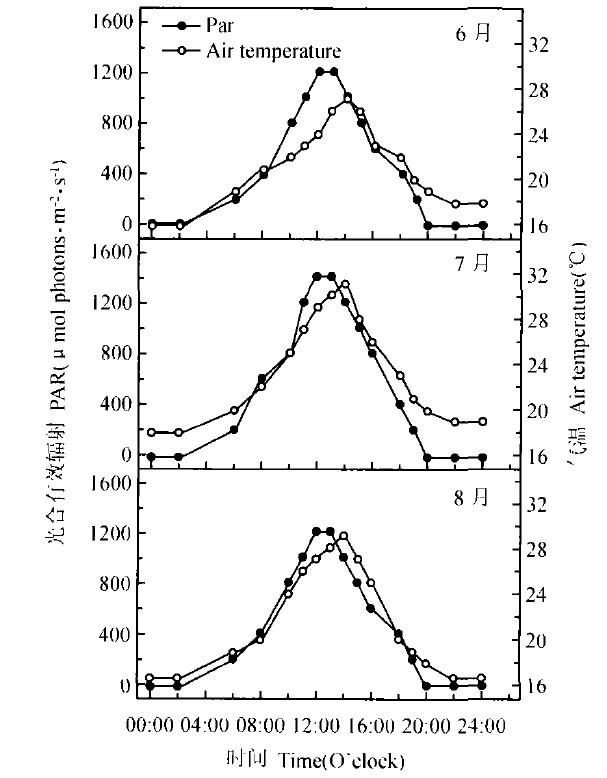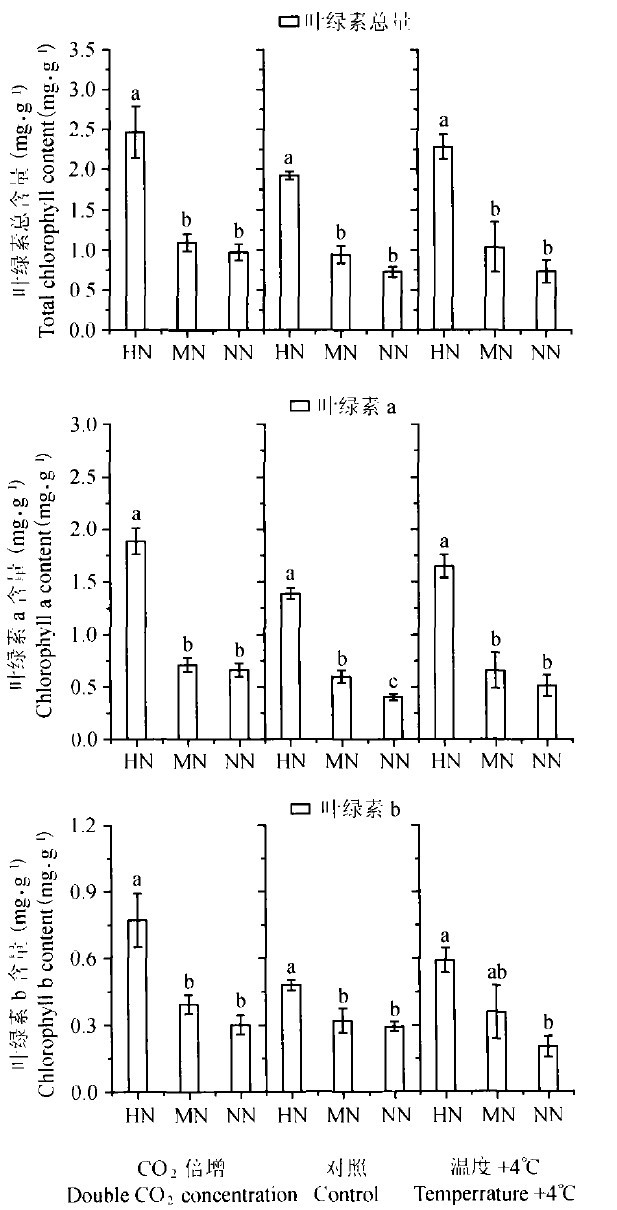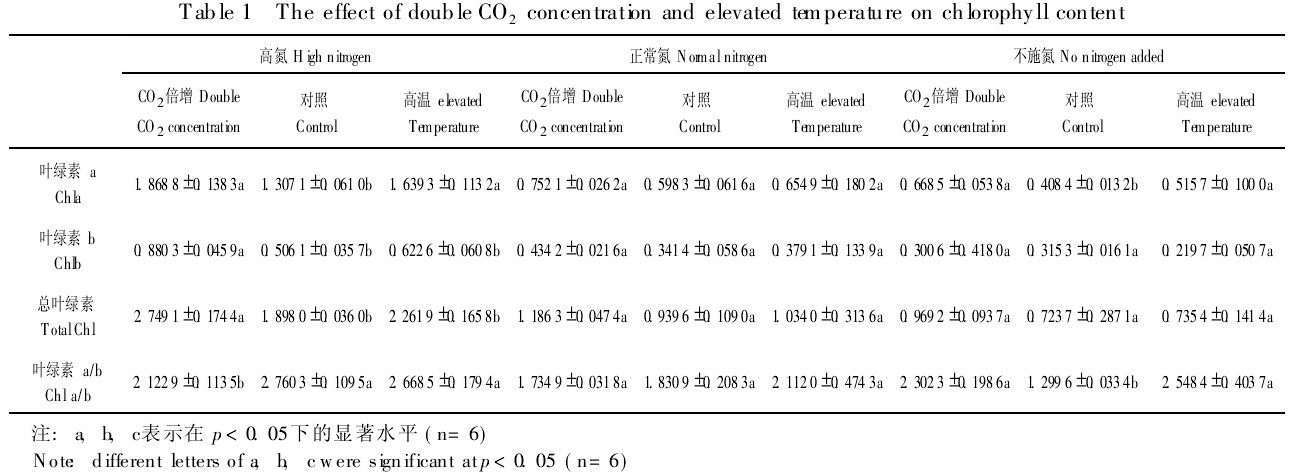Photosynthesis is an important energy source and material basis for plant growth, and the amount of chlorophyll and the a/b value have a direct effect on photosynthetic rate. Chlorophyll content in leaves is an important indicator of plant photosynthetic capacity. CO2 is an important greenhouse gas that causes global change. Since the industrial revolution in the 1970s, atmospheric CO2 concentration has been gradually increasing due to human activities, which has increased from less than 280 μmol•mol-1 to 350 μmol over 100 years ago. •mol-1, and continues to increase at a rate of 1 to 2 μmol•mol-1 per year. It is expected that in the middle and late of this century will reach 650~700μmol•mol -1, double the current, and the temperature will also increase 1~3. 5°C. Temperature has a great influence on the enzymatic reaction and its physiological and biochemical reactions on the cell membrane. CO2 is not only the substrate for photosynthesis, but also the atmospheric CO2 concentration is one of the limiting factors for the photosynthesis of C3 plants, which has a restrictive effect on plant physiological and biochemical processes. Therefore, the increase of atmospheric CO2 concentration, in addition to the greenhouse effect, leads to the indirect effects of global climate change on plants, but also directly affects the photosynthesis and growth of plants. This will inevitably be reflected in the chlorophyll content of the plant leaves. The results of the current study on the effect of elevated CO2 on the chlorophyll content of the plant leaves are inconsistent. Some studies have shown that elevated CO2 concentration can promote the synthesis of chlorophyll, and some results indicate that the CO2 concentration The increase in chlorophyll content in the leaves is reduced. In this study, the effect of CO2 concentration and temperature on the chlorophyll content of Quercus mongolica seedlings under different nitrogen concentrations was studied using a carbon dioxide meter and a chlorophyll detector.
Nitrogen is a basic mineral element in plants, accounting for 1.5% ~ 2% of dry matter of plants and about 16% of total plant protein. Nitrogen is the mineral nutrient element with the greatest demand for plants, and it is also the most common limiting factor for growth of individual plants and even natural ecosystems and artificial ecosystems (including agricultural systems). Nitrogen deficiency is a common phenomenon in most northern hemisphere forest ecosystems and one of the major limiting factors for forest growth. In the northeast, the decomposition rate of forest litter due to temperature and the mineralization process of organic matter are slow. Forest trees are often exposed to nitrogen stress. Due to future climate change, the photosynthesis and growth of plants will be affected by the synergistic effects of various environmental factors, thus revealing that this external environmental factor is very important for the comprehensive effects of plants.
Quercus mongolica is a major tree species of secondary deciduous broad-leaved forest in Northeast China and one of the major tree species in China. It plays an important role in the forest ecosystem in the region. The purpose of this paper is to predict the future increase in CO2 concentration by studying changes in chlorophyll content in leaves of Quercus mongolica with different nitrogen levels under high CO2 doubling and high temperature conditions. With increasing temperature, Quercus mongolica seedlings have different levels of nitrogen nutrition. The changes in photosynthetic use will provide a theoretical basis for the prediction of the biomass of mongolia and the prediction of the future global demand for nitrogen.
1 Materials and methods
1. 1 Materials
The seeds of Quercus mongolica used in the experiment were collected from the forest of Quercus mongolica in Harbin Experimental Forest Farm of Northeast Forestry University in autumn 2004. The seedlings were planted in the spring of 2005, and they were grown under greenhouse conditions. Each seedling was transplanted to a 15 cm×13 cm plastic. In the earthworms, sand (3:1 earth: sand) was cultivated. When the seedlings grow to about 10 cm, the seedlings with the same plant height and growth condition are selected and moved into the artificial climate chamber for experiment.
1. 2 methods
1. 2. 1 Carbon dioxide doubling treatment and high temperature treatment

The E8 artificial climate chamber produced by the Canadian company was used for carbon dioxide doubling and temperature increase treatment. The simulated normal temperature condition was the daily change in average temperature from June to August in the Maoershan area (Fig. 1). The high temperature treatment is an average increase of 4°C under this normal temperature condition. The average humidity is 60%, which is automatically controlled by the climate chamber. At the same time, a control was compared in another artificial climate box of the same type (normal carbon dioxide concentration was 400 μmol CO2 • mol-1 air). The artificial climate box has 3 groups of lamps. Each group of lamps includes a sodium lamp and a metal halide lamp. The light qualities of the two lamps are different. The daylight intensity of the outside world can be simulated by opening and closing the three groups of lamps. Change, the illumination of each sodium lamp and each metal halide lamp is 200~250μmol photos•m-2•s-1. At the same time when three lamps are opened, the light intensity can reach 1200~1500μmolpho2tos•m-2•s-1. Meet the needs of normal plant growth. The average humidity is 60%, which is automatically controlled by the climate chamber.
1. 2. 2 Different levels of nitrogen treatment
In the above three sets of artificial climate chambers, the seedlings of Quercus mongolica were treated with three levels of nitrogen, normal nitrogen and non-nitrogen. The nitrogen was controlled by NH4NO3, and the nitrogen concentration gradient treatment was: 15mmol•L-1N ( High nitrogen), 7.5 mmol•L–1N and no nitrogen (7.5 mmol•L–1 were used as normal nitrogen supply levels). Hogland nutrient solution was applied every 4 days to ensure the supply of other nutrients. And regular watering every morning for 3 months.
1. 2. 3 Determination of chlorophyll content
Chlorophyll content was measured using the chlorophyll meter method: Two pieces of Mongolium mongolicum were removed with a 1 cm2 punch, weighed, placed in a test tube, added with 5 mL of DMSO, and placed in a 60°C water bath. 3 hours (dark place) till the green leaves of the tree retreat. Each leaf was obtained as far as possible in the same part of the leaves. The absorbance at two wavelengths of 649 and 665 nm was measured with a visible spectrophotometer (WJF2100 Shanghai). The chlorophyll concentration (μg•ml-1) was calculated according to the method of Küster et al.

The drawing was completed in Origin 7.5. All statistical analyses were performed using SPSS software.
2 experimental results
2.1 Effect of Different Nitrogen Levels on Quercus mongolica Seedlings

The experimental results show that in the control experiment, the three nitrogen levels on the synthesis of chlorophyll a (Figure 2.5), its content decreased with the decline in nitrogen levels. The chlorophyll a, b and total amount under high nitrogen level were significantly higher than normal nitrogen and no nitrogen, but there was no significant difference under normal nitrogen and no nitrogen application, but the total and normal chlorophyll under no nitrogen application level. Nitrogen has a decreasing trend, but the difference is not significant (Figure 2.2). Nitrogen is an important component of the chlorophyll molecule. Nitrogen content in the culture medium directly affects the synthesis of chlorophyll in the leaves of Quercus mongolica seedlings, especially for the synthesis of chlorophyll a, and also promotes the synthesis of chlorophyll b under adequate nutrition.
2. 2 Synergistic effect of CO2 doubling and different nitrogen levels on chlorophyll content

Under high nitrogen levels, the doubling of CO2 increased the chlorophyll a, b and total content of Quercus mongolica seedlings significantly compared with the control, while the chlorophyll a/b was significantly lower than the control (Table 1), indicating that the conditions were adequate in nutrients. Below, CO2 doubling effectively promoted the increase of chlorophyll content, especially promoted the synthesis of chlorophyll b. Under normal nitrogen levels, CO2 doubling promoted the synthesis of chlorophyll a, b and total content to some extent, while chlorophyll a/b had a decreasing trend, but the difference was not significant (Table 1). At the level of no nitrogen application, CO2 doubling increased chlorophyll a and a/b significantly, but had no effect on chlorophyll b and total content (Table 1).
Under the condition of CO2 multiplication, the difference between high nitrogen level and normal nitrogen and no nitrogen application was extremely significant, the chlorophyll content (a, b, and total amount) increased significantly, and the chlorophyll a/b was stable between the three treatments. Change (Figure 2:1). Normal and no nitrogen also had no effect on chlorophyll content (Figure 2). This shows that the carbon dioxide doubling caused by the adequacy of the carbon source, the plant must have a correspondingly higher supply of nitrogen, in order to ensure a certain level of C / N ratio, to meet the normal growth of plants. Therefore, under the interaction of CO2 doubling and high nitrogen, the chlorophyll content increased significantly (Table 1). Under the condition of insufficient nitrogen source, even if there is sufficient carbon source supply, the C/N imbalance will not affect the chlorophyll content. .
2.3 Effects of High Temperature and Different Nitrogen Levels on Chlorophyll Content
At high nitrogen levels, high temperature (normal temperature + 4°C) only affected the chlorophyll a of M. mongolica seedlings, resulting in a significant increase (Table 1); while the chlorophyll b and total content had an increasing trend, but the difference was not significant; Under the nitrogen level, the chlorophyll content increased with high temperature, but the difference was not significant. Under the condition of no nitrogen application, chlorophyll a/b increased significantly. From the growth point of view, the temperature increased by 4°C so that the Quercus mongolica seedlings did not reach the stress, but to a certain extent promoted the growth of the seedlings, or the temperature may increase by 4°C to approach the optimum temperature for the growth, but The effect of chlorophyll content was not significant. It only promoted the synthesis of chlorophyll a in the case of high nitrogen, and relatively promoted chlorophyll a or reduced chlorophyll b in the absence of nitrogen (Table 1).
Under high temperature conditions, the high nitrogen content significantly increased the chlorophyll a and total contents of seedlings above normal and non-nitrogen levels, and the chlorophyll b content only showed significant differences between high and no nitrogen treatments. There was no change between normal and no nitrogen, and chlorophyll a/b tended to be stable (Figure 2).
3 Discussion
The demand for mineral nutrients for most plants, like the demand for other resources, energy and water, requires a balanced nutritional status to maintain optimal growth. Nitrogen is the mineral nutrient element with the largest demand for plants, and it is also a key component of chlorophyll. If it is lacking, it will not be able to form chlorophyll. Therefore, under the conditions of CO2 doubling, high temperature, and control conditions, chlorophyll a, b, and total chlorophyll show high nitrogen levels. The amount is higher than that of low nitrogen and no nitrogen (Figure 2). The effects of CO2 and temperature on chlorophyll content are constrained by nitrogen. Different nitrogen levels, CO2 and temperature have different effects on chlorophyll content:
Under high-nitrogen conditions, the chlorophyll a content was significantly increased in both CO2 doubling and high-temperature conditions relative to control conditions (Table 1). From the perspective of energy transfer efficiency, chlorophyll a is more indicative of the number of molecules that can be excited by energy. In many cases, the number of molecules participating in photosynthesis is also high, and the photosynthetic product is therefore high. Therefore, under the condition of sufficient nutrients, the doubling of CO2 and the increase of a certain temperature can promote the photosynthesis of plants. The chlorophyll b content was also significantly increased under CO2 doubling conditions (Table 1). From the chlorophyll a/b ratio, it can be seen that when the CO2 concentration is multiplied, the reduction is most significant. This means that the relative content of chlorophyll b is increased, and the ratio of chlorophyll a/b is mainly caused by the change of chlorophyll b. Chlorophyll b is favorable for the plants to more fully absorb the diffused light and the blue-violet light in the reflected light, and enhance the photosynthetic efficiency, thereby promoting the population. Photosynthesis.
Under normal nitrogen conditions, the effects of CO2 doubling and high temperature on chlorophyll a, chlorophyll b, and total amount were not significant (Table 1), suggesting that CO2 and temperature do not contribute to chlorophyll promotion without sufficient nitrogen nutrient supply. Obviously, under the condition of non-nitrogen application, although the content of chlorophyll is very low, the chlorophyll a content is significantly higher than that of the control under the conditions of CO2 doubling and high temperature, but there is no significant difference in the content and total amount of chlorophyll b (Table 1). This shows that when the nutrient conditions are severely stressed, CO2 doubling and increasing the appropriate temperature can promote the synthesis of chlorophyll a to a certain extent, so as to ensure the plant's photosynthetic capacity. However, due to the restriction of nutrients, the synthesis of chlorophyll b cannot be ensured at the same time.
The results of this experiment also show that the temperature during the growing season in Maoershan is not the optimum temperature for the growth of Quercus mongolica, but is lower than the optimum temperature. This is closely related to this kind of wide ecological range. Its natural distribution area is very wide, and it is distributed in North China and Northeast China. Therefore, in the future, under the conditions of warming climate, it can promote the growth of this kind of species. Of course, it mainly depends on the comprehensive effects of various environmental factors.
The results of this study showed that the increase in CO2 concentration significantly increased the demand for N level in the seedlings of Quercus mongolica. The Quercus mongolica seedlings under high temperature conditions also increased the demand for nitrogen to a certain extent.
4 Conclusion
The abundant carbon source brought about by the doubling of CO2, the plant must have a relatively high supply of nitrogen, in order to ensure a certain level of C/N ratio and meet the normal growth of plants. Therefore, under the synergetic effect of CO2 doubling and high nitrogen, the chlorophyll content increased significantly, but in the absence of nitrogen source, even if there is sufficient carbon supply, C/N imbalance, chlorophyll content will not be affected. A 4°C increase in temperature promoted the synthesis of chlorophyll a under nutrient-rich conditions, whereas chlorophyll a was relatively promoted at the level of non-nitrogen (Table 1). It shows that the slight increase in temperature does not cause stress on Quercus mongolica seedlings, but it has a certain role in promoting its growth. Therefore, the biomass production of M. mongolica may increase. At the same time, due to the increase of atmospheric CO2 concentration, the demand of plants for nitrogen will also increase. Under the circumstances of global changes in the future, the phenomenon of nitrogen deficiency in the northern hemisphere forest ecosystem may be aggravated.
pmls
pmls
ZSL MED , https://www.zslmed.com
![<?echo $_SERVER['SERVER_NAME'];?>](/template/twentyseventeen/skin/images/header.jpg)